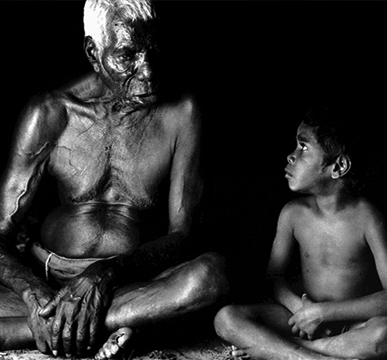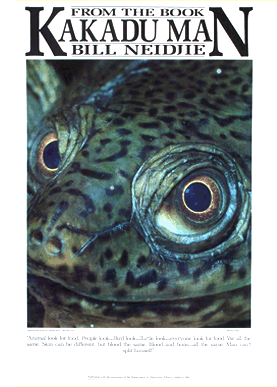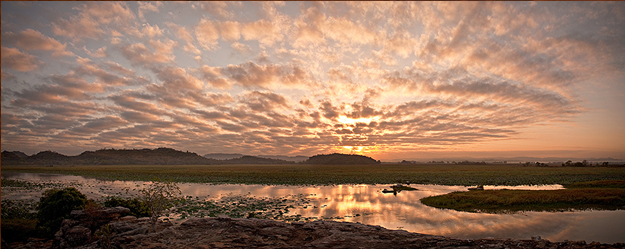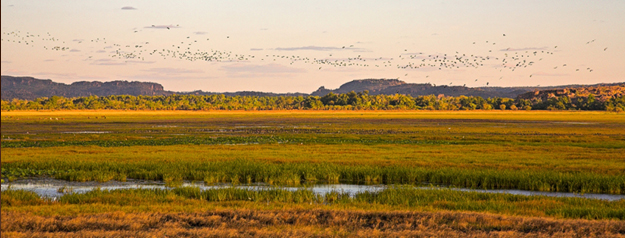
Photograph courtesy of Mark Lang. Copyright Mark Lang
Earth stays
I die and put my bones in cave or earth.
Soon my bones become earth …
All the same.
My spirit has gone back to my country …
My mother.
Big Bill Niedjie, in Australia’s Kakadu Man by Bill Niedjie, Stephen Davis, Allan Fox, Darwin: Resource Managers, 1986, p. 62
Sensitivity statement: Jonathon Nadji, Bill Niedjie’s son, has given permission to use Bill Niedjie’s name and images of him, film and the sound of his voice, as this is what his father wanted. This website contains the names of deceased people.
Overview
On 25 March 2014, the descendants of Big Bill Neidjie gave to AIATSIS for safe-keeping the film footage of his final mortuary ceremony, held on his country in Kakadu National Park. AIATSIS is proud to hold this film for its owners. Welcome to this Online Exhibition which honours the life and work of Bill Neidjie for his people, his country and all Australians, and showcases some of the AIATSIS collections.
Bill Neidjie - The Man

Photograph by Mark Lang, copyright © Mark Lang
Biography
Bill Neidjie was born at Alawanydajawany on the East Alligator River around 1911-1913, son of Nadampala and Lucy Wirlmaka, and spent most of his childhood in his father’s country, the Bunitj Clan land. He went to school at Oenpelli Mission for two years around 1927. When his father died in 1928 he moved to Cooper’s Creek with his mother and later to Cape Don. He learned stories and the law from his father’s and mother’s people.
Bill had various jobs when he was young - as buffalo hunter at Cannon Hill, and later worked at four different timber mills. Before the Second World War and later, Bill worked on a lugger owned by Leo Hickey for more than thirty years, loading and unloading supplies along the north coast.
Bill had returned to his country for visits over the years and in 1979 he returned to his clan land to live on his country and look after it. The Ranger Uranium Environmental Inquiry of 1975-77 recommended that a national park be established and that Aboriginal people be handed back their land. Stage I of Kakadu National Park was proclaimed on 5 April 1979. Clyde Holding, Minister for Aboriginal Affairs in the Hawke Government, said in 1984 “… it has seldom been brought to public attention that no single group of Australian people have acted with the generosity of spirit, that the Aboriginal people in the East Alligator River region have shown in their preparedness to lease to the Commonwealth all of their land in order that it can become part of one large wild area.”
Bill was a claimant in the Alligator Rivers Stage II Land claim in 1980-1981. He was passionate about passing on his cultural knowledge and to that end wrote four books, including Kakadu Man in 1986 and Story About Feeling 1989. He was awarded an OAM in 1989 for service to conservation. Bill Neidjie died at East Alligator Ranger Station in 2002.
Family and Community
Bill Neidjie was head of the Bunitj Clan, one of many in the Kakadu region. His clan area lies to the north west of Jabiluka, with an eastern border reaching to the East Alligator River and into Arnhem Land. In the years before he died, he lived with his family in the homeland of Cannon Hill.
Read more about community and contemporary issues in Kakadu on the Djabulukgu Association Ltd website.
Language
The language spoken by Bill’s clan is Gagudju, from which the name Kakadu is derived. Bill Neidjie spoke Gagudju and was an informant to Mark Harvey who wrote a grammar of Gagudju. Bill also knew his mother’s language, Amurdak, and with Nelson Mulurinj wrote Amurdak Inyman : Six Stories in Amurdak.
Final Mourning Ceremony for Bill Neidjie
The final mourning ceremony, a lorrkkon ceremony, for Big Bill Neidjie was held in 2005 on his country. By taking the body to the final resting place there is a final release of spirit which will now manifest in country.
On 25 March 2014 the ceremony performed in Canberra was a symbolic replication of the lorrkkon ceremony of 2005. By bringing the symbolic ceremony to Reconciliation Place, Canberra, the spirit of Big Bill Neidjie will also be symbolically released here, where the film of the Old Man’s final mourning ceremony is in safe keeping at the Australian Institute of Aboriginal and Torres Strait Islander Studies.
This is what has been said about the ceremony.
This event is immensely culturally significant. The most serious practitioners of ceremony will be involved with it, as they were for the initial ceremony directly after my father passed away. The magnitude of this event may never occur in the Kakadu/West Arnhem region again, if at all in the whole of Northern Australia.
Jonathon Nadji, son of Bill Neidjie and Traditional OwnerHis funeral rites, reserved only for elders of high-degree, were spread over three years (2002-2005). They’re based on practices dating back many thousands of years. Before Bill’s bone ceremony [Lorrkkon ] they had not been conducted in the Kakadu region for many decades and in all likelihood will never be repeated again. read more
Kevin Lucas, Producer/Director (Story About Feeling)Bill's Stories
Big Bill Neidjie’s story is of a passionate man, well versed in the knowledge and law of his country, who wanted to write down his knowledge for his grandchildren and to share the open stories with the wider public.
Culture
The rich culture of Kakadu is expressed in hunting and gathering practices, stories, law, ceremony and art.
Big Bill Neidjie, as he was known, originally because of his imposing stature, was passionate about recording his culture and stories for his children and grandchildren and to this end published three books, Kakadu Man, Story About Feeling and Old Man’s Story: the last thoughts of Kakadu Elder Bill Neidjie. But Bill Neidjie is big in the sense of his love, knowledge and respect of country, his wisdom, his philosophy and his desire to record his culture and stories. His books have reached out and touched and taught many people beyond his immediate family.
Gagudju [Kakadu] Man
Bill Neidjie’s first book is Kakadu Man, written with Stephen Davis and Allan Fox, and was first published in 1985, with editions following in 1986 and 2002 (published as Gagadju Man) . In an overview essay, Allan Fox outlines the importance geography and seasonality in people’s lives. The six seasons of Kakadu influence the kind of activities carried out. Gunumeleng (October to December) is the pre-monsoon season. Gudjewg (January to March) is the monsoon season, or the wet season. Bang-Gereng (April) is a time of food abundance. Yegge (May to June) is a time of cool nights and misty mornings. Fires are lit near campsites and places where green grass will grow. Snakes and flying foxes are the food of Yegge. Wurrgeng (June to July) is the cold weather season when country is cleaned. Fires during the day are dampened by dew at night. Gurrung (August to September) is the beginning of the hot dry season, with food such as rays and sharks, magpie gees, emus, bandicoot and wallaby abundant.
Bill Neidjie, later in the book expresses it this way:
“Wet season … we camp high place,
Get plenty goose egg.
No trouble for fresh water.
Dry season … move along floodplain,
Billabong got plenty food
Even food there when everything dry out.”
Bill goes on to say that this was a time when all Gagudju used to visit – they came to the billabong and the dry season camp and stayed one or two weeks. It was like a holiday – there was plenty of food and it was a good time for ceremony.

Rock Art
The Kakadu region is famous for its rock art and imposing landscapes. It is one of only a handful of places that have gained world heritage status for both its cultural and natural features. The Bunitj Clan along with the Manilaggar people look after the rock art at Ubirr, which is an important rock art site and was a favourite wet season camping place. Art in this area depicts traditional foods and law and creation stories. There are rock paintings that depict contact history – men in trousers and smoking pipes – possibly buffalo hunters. Near the main gallery at Ubirr is the picture of a thylacine or Tasmanian tiger, which are known to have been extinct on the mainland for 5000 years.
One of the images at Ubirr is of Mabuyu, the hunter. This image has been reproduced, and his story told at Reconciliation Place in Canberra.
AIATSIS Collections holds posters which were produced to publicise the book Kakadu Man (see below). Posters reproduced courtesy of the photographers: Ian Morris and Allan Fox.

Indjuwanydjuwa, pictured here in the Red Lily Lagoon , is a creator being who taught the Bunitj people to hunt.

It is said that Bill’s mother stencilled his hand in a cave at Walkarr on the Bunitj clan estate when he was a child.

Long necked turtle is an abundant food in the middle dry season.
Loving Country, Caring for Country
Story About Feeling
Story About Feeling is Bill’s second book. It was produced from a series of tapes recorded by Keith Taylor of Bill Neidjie talking about his country. AIATSIS Collections holds these tapes. Below you can hear extracts from the tapes as Bill talks about aspects of life on country.
Loving Country

Cloud Dreaming by Flemming Bo Jensen. copyright © Flemming Bo Jensen
Bill Neidjie loved his country. Here you can hear him speaking about this
Voice of Bill Neidjie speaking about his love of country. From p. 39, Tape #3 October 9th 1982, 018579
So this part I’m sitting on now, I’ll be in earth because I love it. I love, I love this country and this earth because I’ll come to earth when I dead. And because my country for me; I’ll be buried, stay … and with the spirits
So people be listening this; this story, story for all …
Caring for Country

Birds of the Wetlands by Flemming Bo Jensen. copyright © Flemming Bo Jensen
Bunitj people have always cared for country. Bill Neidjie worked with Ian Morris of National Parks and Wildlife Service in Kakadu National Park. Bill speaks about the practice of burning the country.
Voice of Bill Neidjie speaking about burning country From p. 30 in transcript of 018577
Fire is nothing, when you burn it. I want burn it, fire; because always used to be burn before. And new grass, new grass coming up. That mean good animal eh. Might be goose, goanna, bandicoot used to be, good and long-neck turtle, goanna, possum. They burn it because they didn’t want this rotten grass. No buffalo this time. They got buffalo now.
Threats to Culture and Country

Cannon Hill, Morning. Photograph by Flemming Bo Jensen. copyright © Flemming Bo Jensen
Uranium Mining
Kakadu National Park was created following a recommendation from the Ranger Uranium Environmental Inquiry, although the idea of a national park had been discussed since 1972. The Ranger Uranium mine was not part of Kakadu National Park but is located on the land of the Mirrar Gundjehmi people and is surrounded by the National Park. Uranium has been mined at the Ranger site since 1981. Despite checks on the mine there have been a number of radioactive spills, the most recent being in 2013.
Bill Neidjie told us that his people were worried about mining way back in the 1980s.
From p. 100 of transcript, no. 101 of 018569-018579 ( mp3 audio - 1.4mb)
"This mining here, Aborigine they fright. What we do? We might die … because we don’t know. What for .. they cutting it land?
‘Course, because tree; tree going down and that road e go. Well some bush e grow, e grow grass, spear grass, something grass, nother grass e grow. Soon as bitumen there e don’t grow any grass there. Like that road e stay; no grass – side e’s right, but middle of it … nothing. And you drive, you look lumber stick there. Well you drive … big log there, big dozer been pull out …
Well, your body you feel. You say, “Oh, that tree same as me.” I look tree but I say “oh”, you know, “just like mother, father or brother, grandma or granny.” “Course your granny, your mother, your brother because this earth, this ground … just like your brother to mother or father. This piece of ground e grow you.”
The Collections
Find out about items in the AIATSIS collections that relate to Big Bill Neidjie.
Explore further reading.

Back to top

